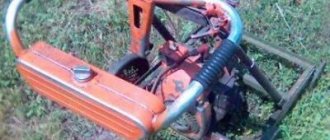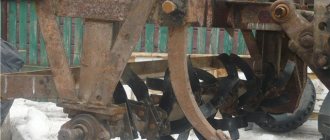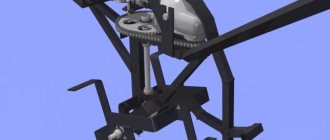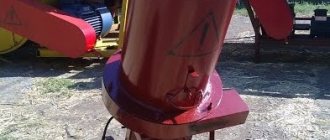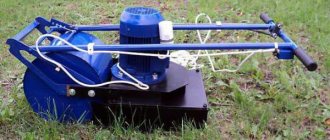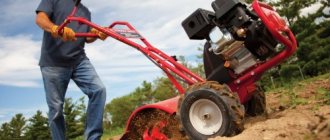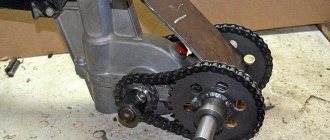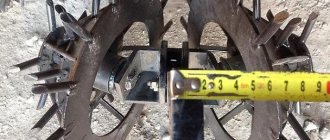Top 5 homemade cultivators: how to design a unit with your own hands
Sometimes it is really more profitable to buy vegetables and fruits in the store. But there is always more confidence in the quality of products grown with your own hands. In addition, working on the land increases vitality if done wisely. But hard physical labor is not always useful, especially for those who are used to working only in the office. To make spring chores enjoyable and not too burdensome, you need to acquire small-scale mechanization tools. Modern equipment can, of course, be bought, but it turned out that making, for example, a cultivator with your own hands is quite simple. Make sure of this.
Weed removal tools
Any work on the site takes a lot of time and effort. But the most tedious task, which requires attention all season long, is weed control. If you tear them with your hands, the remaining roots will begin to grow even more in the fertilized soil. Therefore, it is better to use special equipment that will help remove weeds with roots.
Photo from the site: https://fermilon.ru
Rake
A rake is usually used for collecting mown grass. But they can also help in the fight against weeds, especially on lawns. They are excellent at removing creeping plants and those with shallow roots. The sharp ends of the rake pick up such weeds, but the lawn is not damaged, since the grasses have a strong root system. Rake is useless against thistle or dandelion.
Rake, types of root remover
Root remover
A root remover, as its name implies, allows you to extract the roots of weeds that go deep into the ground. It has many modifications, such as:
- an elongated blade - its end is pointed, blunt or forked - with the help of a handle, press on the ground close to the root of the weed being removed, then, by picking it up, it is removed from the soil;
- v-shaped fork - allows you to grab the root more firmly;
- corkscrew - screw under the plant and roots, pull out.
Option #1: manual tornado - death to weeds
Tornado is the name of a manual cultivator, which you can and should make with your own hands. Having such a device, which resembles a curved pitchfork, you can forget about endless battles with weeds. The teeth of the tool are driven into the ground at an angle, after which the Tornado must be turned and lifted. To do this, you don’t have to exert excessive effort, because instead of a regular handle, the Tornado has a lever.
The Tornado cultivator is attractive because it is quite easy to use and working with it does not require any significant effort
Everyone loves this wonderful root remover, but familiarity with its store price can completely discourage the desire to become its owner. However, there is nothing complicated about this device. The Tornado cultivator can be made independently and even in several different ways.
Spring steel tornado
We will need a steel strip 50 cm long, 1-1.5 mm thick and 2 cm wide. For our purpose, it is best to use spring steel. We bend the tape into a loop and attach it to the wooden handle of the instrument. The length of the handle is determined depending on the height of the owner: it should be comfortable to work with the tool. You can also make a lever, the same as that of a store-bought root remover. The working steel loop should have a diameter of 20 cm, which is slightly less than the row spacing. The edges of the loop are sharpened with a file on both sides.
For weeds - pitchfork to the side
If the Tornado looks like a pitchfork, then why not make a hand-held cultivator with your own hands from this tool familiar to all gardeners? Let's buy a regular fork at a hardware store and give the teeth of this tool the desired bend using a hammer. In general, the tool should resemble a kind of corkscrew. It is important to take your time and proceed carefully.
For the lever you will need a half-meter piece of plastic pipe. We also buy in the store a plastic handle attachment for the handle, which is used for forks or shovels. We cut the tube lengthwise, put it on the handle and secure it with electrical tape so that it does not slip. Now the resulting lever protrudes approximately 25 cm from the handle on both sides.
It is logical to make the fork-shaped part of the Tornado from a fork - a tool well known to all gardeners, which everyone has
An important part for the Tornado cultivator is its upper lever part: thanks to the lever, you can do hard work with minimal effort
Making a tornado cultivator
The tornado garden tool looks like a large corkscrew with handles. Several of its blades are located at an angle to each other. When working, they are screwed into the ground, making the work of the summer resident easier, because there is no need to bend down. The Tornado is ideal for digging ripe potatoes. The bushes of the plant are simply scrolled clockwise and pulled out of the ground along with the tubers. The tool can remove weeds along with the roots and hill up the beds using rotational movements.
Tornado cultivator
Attention! The length of the handle together with the pitchfork should correspond to the height of the person. Blades in a curved state should reach 25 cm.
To assemble a tornado you will need:
- pitchfork;
- plastic nozzle for the handle;
- half a meter of pipe of such diameter that it fits onto a plastic handle-nozzle.
The Tornado cultivator removes plant roots and is also often used for digging up potatoes.
Installation steps:
- The pipe is cut to length and put on the handle so that it protrudes 25 cm in both directions. That is, the top of the handle takes on a T-shape. Secure the pipe with electrical tape.
- The fork teeth are shaped using a hammer. That is, they simply twist them in a spiral.
- Connect the handle and forks. The tool is ready.
Option #2: flat cutter on a bicycle base
A flat-cut cultivator will help you cope with weeds and make the life of any gardener much easier. Structurally, it is more complicated than Tornado, but not much more.
To create a flat cutter you need:
- an old bicycle that no one uses anymore for its intended purpose;
- a head from a cultivator that has become unusable or the working surface of a two-handed saw;
- drill, grinder, keys, drills, bolts and so on.
A bicycle frame and one wheel will be useful. The cultivator head is attached to the frame. The cutting part of a two-handed saw, a small plow, or sharp steel rods made independently can be used for the same purpose. The handles for controlling the mechanism are made of aluminum or steel pipes. A piece of pipe approximately 2.5 cm in diameter will be useful as a cross bridge.
A flat cutter can be made based on an old bicycle, using the working surface of a two-handed saw, ironically called “Friendship,” as the cutting part.
There is no particular complexity in the design of this convenient tool; it can be made if you have suitable material at hand
The structure must be rigid, so the nodes are tightened with bolts. A medium-sized wheel should be secured to the frame with locknuts. The result is a homemade cultivator that is very functional and easy to use.
Types and types of cultivators
First, you should know that cultivators are divided according to the type of food:
- manual;
- gasoline;
- electric.
They are also divided by weight and power. There are ultra-light cultivators, mini ones, they weigh no more than thirty kilograms, ideal for small garden plots and cottages.
There are light cultivators. Their weight is more than thirty, but not more than sixty kilograms. Such cultivators are used on large areas, on plowed fields and virgin lands. Average cultivators weigh up to one hundred kilograms. Well, the largest cultivators are heavy. Their weight is more than one hundred kilograms. Such cultivators are used on large fields and lands.
There is another classification of cultivators - by purpose:
- universal - used for cultivating soil in any area, between rows, they are used for weeding;
- special - for processing a specific variety or crop;
- plant feeders - these cultivators are designed to cultivate the soil and gradually add fertilizers;
- pre-planting, steam – for harrowing any soil before sowing, suitable for summer cottages;
- row crops - for weeding rows in fields where crops have already sprouted.
There are cultivators for cultivating one row, mini cultivators for the garden, and cultivators for cultivating several rows at the same time. They differ in size, because for one row the cultivator is much smaller than for cultivating several rows.
But the most suitable for cultivating the garden and flower beds is a standard manual cultivator. It is lightweight and easy to use. It also takes up little space and is light in weight. There are garden cultivators, they are also small in size, ideal for the garden.
Hand cultivator for weeding
Option #3: disc rotary cultivator
Making a rotary cultivator with your own hands is not at all easy. This requires special skills and good physical preparation. If you have all the listed qualities, you can try to build this tool, which will be much more effective than all the previous ones. With its help, you can not only cultivate, but also harrow the soil, deftly breaking large clods.
The rotary disk cultivator consists of: 1 - disk, 2 - axis. 3 - sleeve, 4 - large bracket, 5 - small bracket, 6 - rod, 7 - pipe, 8 - handle
The working parts of this cultivator are convex disks, which must be welded to bushings placed on the axle. The axial ends are secured with cotter pins, which are secured in a large bracket. After which a hole is cut in the upper part of this bracket. Handles with a crossbar are attached to it. A rod 25 cm long and 24 mm in diameter will have to be welded to a small bracket. A rod of 16 mm diameter is screwed into it. Part of the rod protrudes above the crossbar.
|
It is not so easy to give a 4 mm thick disk the desired spherical shape. To do this, you need to be able to deftly handle a hammer. A strong and precise blow to the center of the disc transforms it into a bowl. This is the work that will require the main physical effort. Special wing nuts located on the crossbar regulate the angle of inclination of the spherical disks relative to the direction of movement of the cultivator itself.
Principle of operation
The working part of the cultivator is installed on the ground surface
Mini cultivator
The Tornado hand cultivator is quite easy to use:
- the working part of the cultivator is installed on the ground surface;
- the handle is turned to the right, and the teeth are deepened by 20 cm;
- the tool is pulled out of the soil, not allowing a reverse turn;
- shake off the soil and continue working according to the same principle.
On a note. When cultivating virgin or turfy soil with a mechanical cultivator, it is recommended to divide the area by drawing squares measuring 25x25cm. If working with soil takes place in a greenhouse or greenhouse, then the handles are positioned at a slight angle to the surface of the earth.
There is a model range of new Tornado manual cultivators:
- cultivator Tornado-mini;
- cultivator potato digger Tornado;
- miracle shovel Tornado;
- super drill;
- garden forks;
- manual cultivator with pedal lever;
- cultivator Tornado “New”.
The mini version of the Tornado cultivator is a smaller model of the tool. Light weight allows you to operate the unit with one hand, making a turning movement with it. Main functions: loosening the soil between rows, weeding, digging holes for planting, cultivating the soil near bushes and trees. The mini-device allows you to loosen the soil around berry fields, for example, strawberries, flower beds. It is used to remove garbage.
The manual cultivator potato digger Tornado, in addition to its main functions, is also capable of digging up root crops. Digging up the soil, the tool picks up the tubers and lifts them to the surface. To do this, it is installed vertically and rotated around its axis. A specially designed row of 4 teeth is screwed under the potato bush and throws the potatoes up. The Tornado potato digger is used for digging up any root crops. Labor-intensive work turns into an exciting process. The speed of work increases noticeably. With a manual Tornado potato digger, you can dig up three times more root crops than with a regular shovel.
Potato digger cultivator Tornado
Miracle shovel Tornado is a tool for tillage. The design of the Tornado miracle shovel is practically no different from similar tools, Plowman or Mole. The tool consists of working forks, a stationary frame equipped with forks, front and rear stops, as well as a handle. The soil is lifted by the teeth of the movable segment of the forks, loosening is carried out by the pins of the fixed part.
When digging with a regular shovel, the back, especially the lower back, suffers the most, since the force is directed upward. The advantage of the Tornado miracle shovel is its competent load distribution. The force is directed downwards, which removes the load from the lumbar spine. Requires 10 times less energy costs. The tool can handle even dry and hard soil; the working depth is 23 cm. The miracle shovel pulls out weeds with roots, just like a cultivator.
Option #4: a production meat grinder to help us
All of the above equipment is quite simple. But in your own workshop you can make a homemade electric cultivator. This once again proves that the possibilities of home craftsmen are almost limitless. To implement this idea, you will need an old industrial meat grinder. On its basis, an effective electric gardener’s assistant will be built.
An electric cultivator can be made on the basis of a meat grinder for industrial purposes: you get a fairly powerful unit that will last for several years
Everything is not as difficult as it seems if you have a welding machine and a master who knows how to use it for its intended purpose. Two corners should be attached to the gear housing. Bent pipes are welded to the corners, which will be used as handles. Another piece of pipe is welded between the resulting handles - a spacer, which gives the structure the required strength.
The axles for the cultivator wheels will also need to be welded to the corners. The wheels are selected to be of medium size so that they are easy to use and do not sink into the soil.
The main structural part is the shaft. It will have to be turned out of ordinary scrap. The connection is carried out as in the original: in a slot. The meat grinder attachment is chipped off with a sledgehammer, after which a bushing with thick walls made of cast iron remains. A blank machined from scrap is placed into it, to which lugs in the form of a screw are welded. They are cut from car springs. Other lug material options were used, but these proved to be unviable.
The lugs are located at an angle of 120 degrees. They need to be screwed out as they rotate, then it will be easier for them to enter the ground, and the cultivator itself will be easier to control. The engine of the device is connected according to the “triangle” circuit, the start is capacitor. For ease of operation, the engine switch is installed on the cultivator handle. The device will last a long time if, before starting work, you lubricate the mating of the homemade shaft in the cast iron bushing with any used oil.
Choosing a device for easily removing weeds with roots
Working on a plot of land takes a lot of time and effort. To make their lives easier, gardeners use various tools that make it easier to perform many tasks on the ground. You can make a device for removing all weeds with roots yourself or buy a ready-made tool. All of them are quite easy to use and help make your work easier. Let's talk about the most common ones.
Hoe
Its second name is sapa. It's something between a shovel and a pickaxe. Sapa is the main tool of gardeners - the most beloved, most widespread and universal. Using a hoe, they loosen the row spacing, hill up potato rows, clear virgin areas of weeds, and break up large lumps of earth. The hoe will help plant seedlings and plant various seeds. The working part of the hoe must be made of high-quality steel. This part is made in the shape of a triangle, rectangle or trapezoid (the latter is most convenient to use).
The handle for the hoe should be comfortable in height and thickness and made of wood.
Sapa (hoe) combined
This weed removal device consists of two tools - a glander and a rake. It looks like a rectangular blade made of steel. One side has a sharp edge (sometimes blunt), the other side has several teeth. The tool must be placed on a wooden holder of a convenient length. Using this tool, you can successfully simultaneously remove and collect weeds between rows of plants located close to each other. In addition, it can be used to clear and level the ground before planting. It will help make furrows, hill up plants, and loosen the soil.
Weed rake
This device helps to carefully pull out a weed plant with a long root from the ground using sharp steel teeth . The teeth stick deep into the ground, grasping the root. This can be done without much effort. Removing the root comes down to several movements:
- insert the tool into the ground where the weed grows;
- we capture it;
- pull it out;
- We remove the weed into a garbage container.
The procedure is clear, targeted and very effective. At the same time, cleanliness is maintained. This tool is convenient to use in flower beds and lawns to destroy weeds with deep roots (sow thistle, dandelions).
Cultivator-root remover
This garden puller will help get rid of the long, rod-shaped roots found in plantain, sorrel, and dandelion. In addition, with its help you can get rid of the roots of old thickened bushes, which can be equated to weeds. The tool looks like a two-pronged fork with flat, wide teeth and a gap between them.
The special arrangement and shape of the root remover teeth helps to do this job quickly and easily. In addition, the device helps to process the tree trunks of fruit trees without harming the roots. The cultivator is easy to handle: it is easy to assemble and operate. The instructions for use will tell you how to assemble it.
V-shaped root remover
This is another option for a root remover. It has a V-shaped blade mounted on a long handle. It helps to easily get rid of weeds with well-branched fibrous roots. This happens quite simply. You use the V-shaped part of the tool to dig up the plant at the very base and remove it from the ground. Long taproots cannot be completely removed, but the bulk of the root will be pulled out. Typically, the root remover is made of high-quality steel.
Fork
Your weed control, anywhere, will not be complete without this tool. The tool has the appearance of a curved metal attachment, which significantly increases the strength of the handle. And this, in turn, allows you to easily cope with weeds that have deep and well-developed roots. Forks with teeth bent at an angle of 45 degrees can do shallow loosening, simultaneously removing weeds that are loosely sitting in the ground.
It should be added that the tool is easy to use, highly reliable, and does not take up much space. In addition, it is easy to use on small pieces of land and where weeds are difficult to reach.
Fokina flat cutter
This device is convenient to use against small weeds. The flat cutter can be buried 2-3 cm into the ground. With its help, you can avoid the tedious plucking of small weeds. When working, it is pulled underground like a scythe, parallel to its surface.
You can make a tool for removing weeds yourself; for this you can use old, unusable equipment, as well as other available and easily accessible materials . Easy-to-use devices will greatly facilitate the fight against weeds.
Weeder
It can be made from a board about 30 cm long and up to 10 cm wide. The board should be processed with a plane, the corners should be rounded and sanded. Then you need to hammer several nails into the board. Determine the quantity yourself. These will be the teeth of the weeder. The thickness of the handle should be made so that it is comfortable to hold in your hands, and its length allows you not to bend over. The handle must be secured firmly.
The weeder is good to use to destroy weeds that have not yet risen.
Ripper
It can be made from old pitchforks. The teeth should be cut, leaving a length of 10 cm, straightened and sharpened. Then you need to insert a long handle so that you can work comfortably without bending over.
Hoe
It will always come in handy: both after rain and after watering. It is used to loosen the soil while cutting weeds. To work with wet soil, a lightweight hoe is more convenient. To do this, you need to cut a rectangular hole in the plane of the old hoe. The soil will pass through the hole, which means it will stick less to the working plane.
Hand cultivator
It is made from durable sheet metal. To make it, cut out 4 strips 15 cm long and 3 cm wide, as well as a base bar (any size). Then bend them at a right angle and weld them to the bar. The holder should be secured on the reverse side. The metal working part of the cultivator must be sharpened. You will get a lightweight cultivator that can be used to loosen the soil and remove weeds.
Root remover
A root weed remover can be made from a spade. Its canvas needs to be cut on both sides, starting from the top, and narrowed towards the bottom. This tool is very convenient for deep cutting the roots of bushes.
Success in the fight against weeds can only be achieved by applying comprehensive measures to destroy them. Special equipment can be of great help with this. Each device fulfills its purpose, so they should be selected individually, in accordance with the circumstances that have developed in your garden.
How to make a manual Tornado cultivator at home
When spring comes, summer residents and owners of personal plots begin planting work.
First, the soil is prepared for this, and only then the plants are planted. The most labor-intensive process is loosening and digging the soil. Many people use a shovel for this, but there is a more convenient device - a cultivator, with which you can quickly and easily process even large areas. This tool can be purchased at the store, but with some skill you can make it yourself.
Description
And although the Tornado is a device with which you have to fight weeds manually, it is a universal model that is great for garden maintenance. Despite all its simplicity, the device allows you to greatly simplify agricultural work.
Using the Tornado cultivator, it is possible to make the soil loose, and it is fashionable to work with the Prior on any site, regardless of size. The design features of the equipment make it possible to perform the process of loosening the soil quickly and easily, which cannot be achieved when using a conventional shovel.
Weed extractor Tornado
Distinctive features of the Tornado weed extractor include:
- Using the device, it became possible to perform various soil treatments. This includes loosening, removing weeds, digging, and making holes for planting.
- A gardener can carry out work with a straight back, and he will have to make a minimum of effort. This effect is achieved due to the fact that the Tornado cultivator is able to evenly distribute the load across different muscle groups.
- Due to the geometric features and strength of the teeth, it is possible to process even complex and neglected areas.
- The presence of an arched lever handle allows you to loosen the soil as quickly and conveniently as possible.
- Assembly of the unit is easy and quick.
- The device can be disassembled into three parts, so its transportation is easy.
- Cultivation width and depth are 260 and 220 mm.
Maybe
What is the tool
The most common are hand cultivators, whose weight is no more than 20 kilograms, they are compact and have high productivity .
With this device you can not only loosen the soil, but also remove weeds and apply fertilizers. The tool will also come in handy during the care process after planting the plants; with their help you can perform the following actions:
- hill up the beds;
- thin out;
- loosen the soil between the beds.
Of course, such a hand tool is certainly not comparable in capabilities to a walk-behind tractor, but it is quite suitable for performing the assigned tasks.
It can also be used even in hard-to-reach areas. Cultivators are equipped with cutters, thanks to which they move around the site, and they are the ones who carry out loosening. In addition, it can have the following working attachments:
- paws for thinning and loosening the soil;
- sock for cutting and loosening;
- hiller for cutting furrows for subsequent sowing. Then it will help in the process of hilling the plants;
- a needle-shaped disk, it is needed if the soil is covered with a large crust;
- Feeding knives are equipped with dispensers so that fertilizers can be injected into the soil.
How to use
After you have purchased the device, you need to adjust the height. Only then can work to remove weeds be carried out. The teeth must be immersed in the ground using your hands. In this case, you need to hold on to the transverse upper handle. Using the side handle, perform a rotational movement and at the same time tap the teeth of the device onto the surface. By performing all these movements sequentially, you can simply remove all the weeds, but also loosen the soil.
The video shows how to use the Tornado weed extractor:
Classification of cultivators
There are several types of such devices, but in order to choose one or another option, you should know more about each of them.
For example, the design of a rotary ripper includes four moving discs, one rotating blade handle and staples. In addition, it is equipped with wheels and a long handle. Using this device you can perform the following actions:
- loosen the ground;
- enrich it with fertilizers;
- remove weeds.
The device is set in motion by pressing on the handle and the sprocket assembly, then it turns.
Another type of device is a mini model . It is specifically designed for use in gardens or small greenhouses. With its help, the soil is cultivated around trees and shrubs, weeds are also quickly removed and holes are dug for seedlings and small garden crops.
|
The gasoline cultivator is equipped with an engine, which is needed to operate the cultivating cutters. Their working depth is 150 mm; they are often used to lay out new landscapes. They can also quickly plow heavy soils and remove weeds by the roots.
The manual cultivator-ripper looks like a small rake and is equipped with 3-5 curved teeth with sharp ends.
If you apply a little force, they can loosen the soil and break the crust on it. When the teeth enter the soil, the device pulls towards itself to create furrows. Options for tools with long handles are used in the garden, and with short handles - on flower beds and indoor plants.
Root remover - ripper "Tornado" has pointed spiral-shaped teeth with diversified directions. First, the device is placed vertically in relation to the ground, then rotated 60 degrees and buried in the soil, and then turned clockwise again. Then the device is lifted, and the roots are removed with it.
The depth of treatment using Tornado is 20 cm; accordingly, only weeds are removed, and planted crops are not harmed.
Electric tools are designed to work in small areas; they are compact and have good maneuverability; accordingly, they can be used near bushes and trees and hilling them.
Make sure in advance that the cord is long enough to freely cultivate the soil. This cultivator is environmentally friendly and can be used in greenhouses.
What kind of device is this, how does the cultivator work?
In short, the Tornado cultivator is a root remover or baking powder, an environmentally friendly multi-tool with several functions.
The design of the Tornado hand cultivator consists of a metal rod. A handle similar to a bicycle handlebar is installed on one side of the rod. The other end is equipped with teeth. However, those same teeth have a spiral shape, turned counterclockwise.
An important design feature of such an instrument is the adjustment of the rod according to height. Because of this, the tool can be used by a capable person of any height, and even by a child taller than 1 meter.
Many people will ask, how does such a tool work correctly? It's simple - you need to install it perpendicular to the plane of the ground and turn it until the teeth are completely immersed in the post.
A lot of good videos have been made about the work of the tornado cultivator. For example, this:
Even a fragile girl can easily cultivate ridges of several tens of meters with just such a cultivator. Interestingly, the load distribution is thoughtful. The user does not strain his back, but works with all parts of the body. Arms, back, shoulders, legs and torso are involved. If there is a distribution of the load, then it is almost impossible to become exhausted when working with the tool.
Experts advise using just such a tool in abandoned or neglected areas, because removing weeds and wild plants is the main function of a cultivator. Compared to a hoe, this cultivator will save both time and effort. There is no need for an awkward body position when working, as well as periodic bending and squatting.
How a hand cultivator and a tornado root remover work in practice is shown in the video:
If you test a cultivator or root remover together with a shovel, you will find that the shovel processes the soil 4 times slower. Moreover, it doesn’t matter who exactly used the tools, because when comparing, you need to perform chaotic movements at a certain pace.
Proper tillage is carried out by loosening, and not by moving the layer. The natural layer and fine root system are destroyed during aggressive digging with an ordinary bayonet shovel. Proper use of a root cultivator preserves the right environment for future plants.
Benefits stated by the manufacturer:
- Removing weeds is a pleasant, simple task. You just need to plunge the working pins of the cultivator around the weed.
- It is convenient to get rid of unwanted vegetation on the ridges. It is impossible to spoil the growing crop with such a tool.
- You can do the same thing as with a pitchfork, distributing weeds into compost pits or piles.
- Easy to assemble, convenient to store and easy to transport from site to site.
- The working rods or teeth are made of hardened steel and are resistant to corrosion.
Homemade hand cultivator
It is quite possible to make a manual cultivator with your own hands , without the need for any special tools or materials. The work may take no more than a day, it all depends on the chosen design and configuration of the future tool.
The parts are simple and reliable, but if the tool does break, replacing the broken part will be easy. It can be made from existing materials.
Another advantage of making a device yourself is that it is quite simple to make it even without special education.
Assembly instructions
assemble such a device from various available materials , and there are both simple and more advanced options.
An old bicycle that can no longer be repaired can serve as the basis for production; you will also need an old two-handed saw or a head from a used cultivator. The tools you will need are:
From the bicycle you only need to take one wheel and frame. You will need to attach the cultivator head to the frame, and if it is not there, then half the tip of a two-handed saw, or steel rods, or sharp metal rods with sharpened ends. Attach handles based on aluminum or steel pipes to the bicycle handlebars. A transverse jumper is placed between them.
DIY electric cultivator
In a workshop, you can make an electrical device based on an industrial meat grinder. Moreover, the model does not play a role here. And if you approach the work competently, then in the end you will assemble a fairly powerful device. It is important to note that you will need a welding machine to work.
Manufacturing instructions:
- Two corners are attached to the gearbox, pipes with bends are then welded to the corners, which will serve as handles;
- to increase strength, a steel bridge is welded between the handles;
- the axles of the cultivator wheels need to be welded to the corners;
- provide lugs on the wheels, which can be made on the basis of car springs; they are welded onto the wheels;
- connect the engine. For capacitor starting, the switch is placed on the handle of the device.
Using such a unit under conditions of rapid movement will allow you to roughly plow the ground, and if it works slowly, you will get a fine fraction.
Do-it-yourself Tornado cultivator
The homemade Tornado device will allow you to perfectly loosen the ground due to its twisted teeth. The pipe serves as a lever and is attached to the handle. The pipe must be at least half a meter long. The lever fixed in the pipe should protrude 25 centimeters into both sides of the handle. To strengthen the fastening, you can use electrical tape. Spiral teeth are made on the basis of spring steel, but their diameter should be a maximum of 20 cm. This size is optimal for the convenience of weeding the space between the rows.
About "Tornado Mini"
Externally similar to a cane, the lightweight manual cultivator Tornado mini is an excellent assistant in removing weeds and shoots.
It is necessary to constantly improve the garden and dacha area, but most physically cannot cope with such monotonous work. Digging up small sprouts with a spatula or grapple is much more labor-intensive than “picking up” unnecessary vegetation with a simple movement of the hand. The Tornado mini cultivator is a lightweight version of the classic model. Differences and capabilities of this tool, specified by the manufacturer:
- Loosening without turning the earthen layer. Can be used near bushes, next to flower beds and in other hard-to-reach places.
- Simple and easy removal of small weeds.
- Creating holes for planting onions, flowers, seedlings of any size in a short time.
- Treatment of the topsoil next to the root system of shrubs and trees.
- One-handed operation.
If you have doubts about the choice of cultivator and its price, then it is better to purchase the most budget model - the Tornado root cultivator.
Tips and tricks for working independently
If you decide to assemble such a tool yourself, then do not forget to follow the necessary safety precautions . Above all, take care of your eyes, especially when welding, no matter what type of welding.
Thus, when arc welding, the danger is represented by the intense light obtained as a result of combustion and arc, as well as scale that appears at the site of the frozen weld seam. When the metal cools, it can suddenly break off and fly to a great height.
If you use gas welding to heat metal for processing or cutting, do not forget to wear gloves and face shields, since the work is carried out at high temperatures. You also need to remember that oxygen, when in contact with oil, creates an explosive mixture that does not even require a spark.
When you decide to make your own farm equipment, you can save money on purchasing it .
And even if you do not have experience or special skills, you can make your own cultivator from an old bicycle of the simplest type and provide yourself with good help when cultivating the land.
Advantages and disadvantages of cultivators
Each type of cultivator has its own pros and cons. Electric cultivators are lightweight and small in size. They don't need to be refueled because they run on electricity. They are also quite simple and easy to use, but are not suitable for a dacha that does not have electricity.
The disadvantages include the fact that they only work in the area where the power cord reaches. Also, electric cultivators do not have high power. With such a cultivator you can cultivate flower beds and greenhouse soil, but in large areas they are completely useless. After all, the length of the cord determines the place where this cultivator can cultivate the soil.
A cultivator that runs on gasoline (gasoline cultivator) has slightly more advantages. It is convenient to cultivate large areas, because such a cultivator has high power and functionality. Disadvantages include difficulty in maintenance, heavy weight and refueling. And the more powerful such a cultivator, the more fuel is needed to refuel it. Gasoline cultivators are often called star cultivators.
Cultivator: purpose and characteristics of types
Cultivators are very convenient and popular agricultural tools used to perform surface loosening of the soil, as well as destroying weeds, applying fertilizers and cutting furrows for irrigation activities. When choosing a model of such equipment, you must be guided by the following basic parameters:
- relief features of the site;
- useful area of the site;
- qualitative composition and characteristics of the soil;
- scope and criteria of assigned tasks.
Depending on the purpose, there are several main types of agricultural cultivators:
- continuous tillage during pre-sowing tillage with simultaneous harrowing;
- inter-row tillage of the soil and simultaneous fertilizing of cultivated crops with basic mineral fertilizers;
- pre-sowing tillage, represented by loosening and layer-by-layer grinding of the soil, as well as the destruction of weeds, leveling and compacting the soil.
Equipment can also be classified depending on the operating mechanisms:
- electrical equipment used on small plots of land. Operation is ensured by electricity. The equipment is lightweight, compact in size and does not emit harmful substances into the environment. Disadvantages include low power and low mobility;
- battery equipment designed for soil treatment in small areas. The difference from electric models is sufficient mobility while maintaining small dimensions;
- Gasoline equipment is the most popular due to its high performance. Such units are quite powerful, mobile and convenient. The main disadvantages of the application are the emissions of harmful substances into the atmosphere, as well as the need to regularly perform competent maintenance.
Another fairly popular type of garden equipment among owners of country property is a hand-held cultivator, represented by a simple design in the form of bent hook fingers or metal stars, which are attached to a metal holder. Such homemade products allow summer residents to quickly and easily cultivate the soil , and for production they will need the correct drawings, a little time and available tools.
Types and models
The manual cultivator "Tornado" is a real assistant for gardeners and summer residents. The first model of the instrument appeared on the market in 2000. It was released by the Russian company, which received the manufacturing rights from the talented inventor V.N. Krivulin. Today, the manufacturer produces cultivators of various modifications. It is worth considering several of the most popular varieties.
Mini-cultivator “Tornado TOR-32CUL”
This is a universal device that allows you to carry out various types of work both in the garden and in the vegetable garden. Most often it is used for loosening the soil between rows, weeding from weeds, cultivating the soil between fruit bushes, trees and in flower beds. Thanks to this cultivator, you can also prepare holes for planting vegetables and flowers. Additionally, many summer residents try on a device for cleaning the area from fallen leaves. The tool is easy to use and weighs only 0.5 kg.
How to make a cultivator with your own hands
Of course, reliable and high-performance devices cannot be cheap, so many gardeners prefer to make simple but effective designs themselves. Properly designed hand cultivators are economical, do not require refueling and can replace several tools at once, including a shovel, hoe and rake. Such devices take up minimal storage space.
Homemade disc rotary cultivator
It is not too difficult to independently make a rotary disk tool designed not only for soil cultivation, but also for leveling the cultivated area. A correctly assembled structure allows you to level the surface, harrow the area, and break up clods of earth. The main parts of the unit are represented by a disk, an axle, a bushing, large and small brackets, a rod, a pipe and a handle.
|
Spherical-type working parts in the form of convex disks must be welded to bushings that fit onto the axle. Using a cotter pin, the axial ends are fixed in brackets. Using a special ledge, a pipe is passed through a large bracket, as well as handles and a crossbar. The diameter of the rod is 2.4 cm with a length of 25 cm . This part is welded onto a small bracket. A rod with a cross section of 1.6 cm must be screwed into the rod, which should partially protrude above the surface of the crossbar.
The main difficulty in manufacturing the unit is represented by the need to give the disks a neat spherical shape using fairly strong hammer blows. The angle of the disk installation relative to the movement must be adjusted using wing nuts that are attached to the crossbar.
How to make a Tornado cultivator with your own hands: drawings and manufacturing steps
In the gardening market, a relatively simple, in terms of design, but quite effective device called the Tornado cultivator is increasingly found. This unit is a kind of corkscrew, mounted on a vertical stand and having a horizontal handle.
The easiest way to make this version of manual equipment yourself is to use ordinary gardening forks and a plastic handle attachment for the cutting. The step-by-step technology for manufacturing a homemade Tornado unit is as follows:
- prepare a piece of plastic pipe, the length of which should be 50 cm;
- the diameter of the plastic blank should slightly exceed the thickness of the plastic handle attachment;
- the pipe must be carefully cut lengthwise, which will allow you to turn it out and put it on the handle, and then secure it with electrical tape;
- a correctly assembled handle has edges protruding on both sides of the handle by about a quarter of a meter;
- The teeth on the forks need to be given a corkscrew shape characteristic of the working unit using a regular hammer.
The bends on the teeth should imitate as accurately as possible the shape of the working part of the original Tornado cultivator.
Homemade manual cultivator from a bicycle
To make a convenient and durable unit yourself using available materials, you need to prepare an old bicycle frame and one wheel. The step-by-step method for assembling such an agricultural unit is as follows:
- fix the cultivator head on the frame, which can be used as ready-made parts of an old device or a self-made structure based on steel rods;
- install a frame, which is best used as a small plow;
- such a homemade cultivator is controlled using a handle made on the basis of a standard steel pipe;
- install a crossbar from a pipe with a diameter of 20-30 mm.
It is recommended to secure all parts of the structure assembled from the bicycle with a reliable bolt connection. To ensure ease of control, the unit is complemented by a medium-sized wheel, which is secured with locknuts. This version of the cultivator is optimal for removing weeds between the beds.
Homemade manual cultivator with attachments (video)
How to make an electric cultivator
There are several known options for manufacturing such a device, but the most popular variety is a homemade electric cultivator based on the engine of a conventional meat grinder:
- the gearbox and electric motor are located on the frame;
- the working parts of the mechanism are fixed to the output shaft of the gearbox;
- The steering wheel and wheels are attached to the frame.
DIY tornado shovel drawings
Manual ripper, Buy an inter-row cultivator, Buy a tornado cultivator in Leroy Merlin, Where to buy a clutch handle for a Texas cultivator, Buy a mini cultivator
What is a tornado shovel do it yourself drawings
Due to the amazing principle of operation, there is almost no load on the lumbar part of the back, excluding bending, which preserves health and creates a good mood during work, and the speed of tillage (loosening, digging for planting, removing weeds) is 3 times faster than with a shovel.
Compound
Where to buy a clutch handle for a Texas cultivator
Buy a mini cultivator
Manual earth ripper
Tornado root remover buy cheap
A miracle shovel for digging earth has recently become a common tool in a personal garden or summer cottage. At the same time, some devices have quite noticeably replaced the familiar ones in households. We will deliver on time! Offices in 49 cities of the Russian Federation. Cultivator, drill, root remover, potato digger, shovel, extractor. Favorable prices. Pickup/delivery. Service, guarantee. Shovel Snow shovel Tornado at a great price
Effect of use
An important design feature of such an instrument is the adjustment of the rod according to height. Because of this, the tool can be used by a capable person of any height, and even by a child taller than 1 meter. Last year, I was sure that the only thing better than a shovel is a shovel. Although, this device, called the Tornado manual cultivator, was already on our farm. Since I wasn’t the one who bought it, I treated this cultivator with prejudice, irony and sarcasm. But in vain...
Expert opinion
The Tornado cultivator model has been on the garden tools market for several years now and has earned widespread attention and approval from people with spinal disorders. Practicing users claim that the main load is only on the hands.
We will deliver on time! Offices in 49 cities of the Russian Federation. Favorable prices. Pickup/delivery. Service, guarantee. from 29990 rub. Caiman cultivators. Japanese quality! HONDA and Subaru engines. Goodster knows where people buy hand cultivators for their dachas in Ryazan cheaper. Hand cultivators for a summer residence in Ryazan. 560 products. In the 220 Volt online store in the Ryazan region you can buy hand cultivators and rippers, compare prices and technical specifications. More than 100 models. Manual cultivator for the TORNADO cottage today at a super price! There are 7 items left on sale. Official site. Maintenance, repair, sale. Call. Weeder flat cutter on a frame with a double handle and wheel, furrower and plougher. Safe, easy to use. There is no load on the spine. 80% less effort
Purpose
Before we begin the story about the Tornado cultivator, we should tell you how to choose this technique in general. Firstly, preference should be given to those manufacturers of garden tools that have been around for a long time. Secondly, it is worth considering the power of the device: for example, for a small dacha, a simple unit, the numerous functions of which have received good reviews, is quite enough. The Tornado cultivator is one of the ideal cultivators for this parameter. Thirdly, you should take into account the terrain, the condition and composition of the soil, as well as the size of the area where you will have to work. Fourthly, many models of cultivators can perform various functions: preparing the ground for planting, harrowing it, digging up roots, and so on. Accordingly, this parameter should definitely be taken into account.
Favorable prices. Pickup/delivery. Service, guarantee. At a great price! Delivery/pickup! Discounts and promotions every day! Hurry up. 2 shops. Selection by parameters. Delivery from stores in Belgorod and other regions. 49 offers available! In the category: viking hb 585.1 cultivator buy at a good price, delivery: Belgorod, discounts. Choose from 28 products in the viking 585 cultivators category in stock! Delivery: Belgorod, Discounts! Goodster knows where people buy viking 585 cultivators in Belgorod cheaper :). RUB 52,990 The Viking HB 585 cultivator is powerful, easy to operate, has a stable design, durable components, and is most effective when digging, digging and cultivating. RUB 52,990 If you are looking for where you can buy an inexpensive petrol cultivator HB 585, contact us. We not only offer to purchase equipment in Moscow, but also deliver it to all cities of Russia. 2.3 kW / 3.2 hp, plowing width 85 cm, number of forward/backward gears 1/1, cutter diameter 32 cm, number of ripper stars - (2+1)x2, weight 46 kg. Collapsible plowing kit to reduce working width. An excellent selection of walk-behind tractors and walk-behind cultivators in Belgorod. from 29990 rub. Caiman cultivators. Japanese quality! HONDA and Subaru engines. High-quality children's shoes at myToys.ru! Large selection + Russian delivery. European level hypermarket. Promotions and special offers. Large warehouse. Order!
How to choose the right ready-made cultivator in the store
The process of choosing such a technically complex product as an agricultural cultivator does not cause difficulties, but requires mandatory consideration of the following nuances:
- power parameters for gasoline models are expressed in horsepower, and for electric models in kW;
- the standard power range, regardless of engine type, is 4-8 hp, but the optimal and most economical power is 6.0-6.5 hp.
- the value of the working width is determined by the distance between the leftmost and rightmost cutter, but in amateur models it is limited to 85 cm.
- the presence of four or more cutters in the working body of the equipment makes it possible to change the working width towards decreasing and increasing;
- in a medium-static mechanism, the tillage depth is most often 330 mm, but if necessary, you can choose more or less productive models;
- a significant part of low-power and light models are equipped with one standard gear, which allows forward movement, and a small force helps to turn the unit in the direction required for work;
- on heavier models, the presence of reverse gear is a necessity, allowing you to give heavy equipment the desired direction;
- The engine can be two-stroke or four-stroke, which has a direct impact on the power of agricultural equipment.
It should be noted that two-stroke engines are easier to maintain, but quite noisy. When choosing factory models, you must also remember that a flat cutter exclusively trims all newly emerging shoots, and the use of flat cutters allows you to make a kind of batch from the soil.
